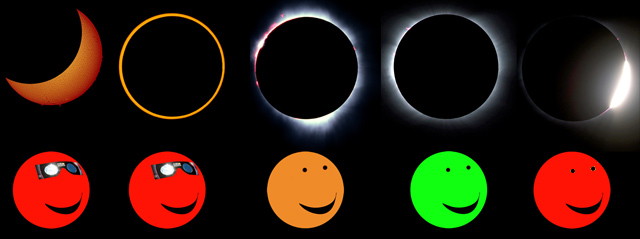|
The observation of solar eclipses may bring significant risks for eyesight. During partial or annular eclipses (see the two drawings on the left on the illustration below), it is mandatory to wear eye protection to prevent eye damage, particularly for children.
Ophthalmic risks are real, particularly during the hours closest to solar noon, at which time the short wavelength visible radiation and ultraviolet light from the Sun are least absorbed by the atmosphere.
Ophthalmic risks linked to a direct observation of the Sun, are of two kinds:
- corneal lesions of the keratitis type, related primarily to ultraviolet light, painful but usually reversible within days,
- retinal lesions or burns related to the thermal effect of solar radiation and to a photochemical effect on retinal cells that are particularly vulnerable. This effect can be irreversible and ultimately lead to impaired eyesight, or even blindness.
To observe such event with good eye safety, it is mandatory to use special protective goggles that are completely opaque to visible light. These eclipse glasses are personal equipment and should comply with the provisions of European directive 89/686/EEC on personal protective equipment, and carry the CE mark of conformity. Eclipses glasses should also meet the more recent ISO 12312-2:2015 standard.
The filtering part is made from either polyester film coated with a thin layer of aluminum foil or black tinted polymer film (the latter is much less fragile and more stable over time). These films are usually embedded in cardboard mounts. The cardboard-framed glasses should be considered disposable. The optical quality of the filter can deteriorate if the glasses are stored in poor conditions.
It is also possible to use welding glasses, either held directly by hand or mounted on cardboard for protection. This glass must be of shade #14, of good optical characteristics under the European standard EN 169/1992. Such filters can be reused and will not deteriorate or change over time; it is currently the best protection if properly used.
People should be warned against using other means of protection, such as smoked glasses, X-ray films, CD/DVD disks or just sunglasses whose faculty of protection is very low.
In no event shall the Sun be observed with optical instruments (binoculars, cameras, ...) without using suitable filters placed at the opening (extremity pointing towards the Sun). Similarly, eye protection at the rear of an instrument should be avoided in all circumstances because they are not designed to absorb such an amplification of solar radiation; the appropriate filters can be purchased at astronomy stores.
It is also advisable to limit the continuous observation time starring at the Sun and make a pause between two observations in order to let the eyes rest.
Parents should take special care to protect their children.
The illustration below gives you an indication of when you should wear the eclipse glasses.
|



